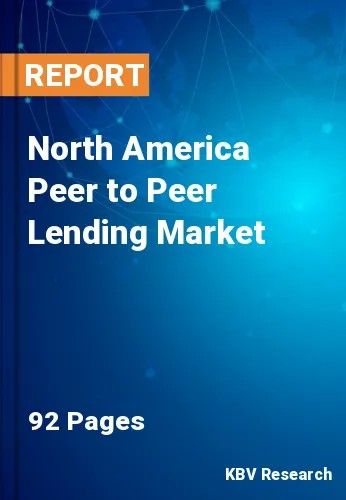The North America Peer to Peer Lending Market would witness market growth of 27.4% CAGR during the forecast period (2023-2030).
Artificial intelligence and machine learning use is growing in P2P lending for better risk assessment, fraud detection, and personalization of financial products. The increasing importance placed on sustainability and ethical principles has resulted in the rise of peer-to-peer lending platforms catering to green and ethical lending. As a result, these platforms have successfully attracted investors who prioritize environmental consciousness. Regulatory scrutiny of P2P lending is increasing as the industry grows. Finding a delicate equilibrium between fostering innovation and safeguarding consumer interests remains a complex task, and the supervision of regulations will persistently adapt and develop.
P2P lending is not static; it continues to evolve and innovate, introducing new features and technologies to enhance their services and meet the evolving needs of borrowers and lenders. Many platforms now employ AI algorithms to assess the creditworthiness of borrowers. These algorithms can analyze various data points, leading to more accurate risk assessments. Recognizing the importance of mobile access, platforms have developed mobile applications that allow users to manage their lending or borrowing activities on the go. Some P2P lending platforms have integrated cryptocurrencies, allowing investors to use digital assets as collateral or to invest in crypto-related loans. This provides diversification opportunities and attracts crypto enthusiasts.
As per the report titled Small Business Profile 2022, released by the Government of British Columbia, in the British Columbia province of Canada, this province exhibits a higher per capita concentration of small businesses, a greater proportion of the workforce employed by these businesses, and a higher prevalence of self-employment compared to other provinces. Small businesses constitute 98% of the total number of businesses in British Columbia. One in ten British Columbians are entrepreneurs in a province with 5.2 million people and 510,700 small businesses. Therefore, the growth of startups and small businesses in the North America nations will help raise the demand for peer to peer lending platforms in the region.
The US market dominated the North America Peer to Peer Lending Market by Country in 2022, and would continue to be a dominant market till 2030; thereby, achieving a market value of $352,208.5 Million by 2030. The Canada market is exhibiting a CAGR of 30.2% during (2023 - 2030). Additionally, The Mexico market would experience a CAGR of 29.1% during (2023 - 2030).
Based on Business Model, the market is segmented into Traditional Lending, and Alternate Marketplace Lending. Based on Loan Type, the market is segmented into Small Business Loans, Consumer Credit Loans, Real estate Loans, and Student Loans. Based on End User, the market is segmented into Business, and Personal. Based on countries, the market is segmented into U.S., Mexico, Canada, and Rest of North America.
Free Valuable Insights: The Global Peer to Peer Lending Market is Predict to reach USD 1.1 Trillion by 2030, at a CAGR of 28%
The market research report covers the analysis of key stake holders of the market. Key companies profiled in the report include Harmoney Corp Limited, Funding Circle Limited (Funding Circle Holdings plc), LendingTree, LLC (LendingTree, Inc.), Upstart Network, Inc. (Upstart Holdings, Inc), LendingClub Bank (LendingClub Corporation), goPeer Corporation, Linked P2P Limited, Prosper Funding LLC (Prosper Marketplace, Inc.), Lending Loop (Loop Financial Inc.), and MoneyMe Limited.
By Business Model
By Loan Type
By End User
By Country
Our team of dedicated experts can provide you with attractive expansion opportunities for your business.

